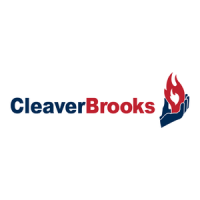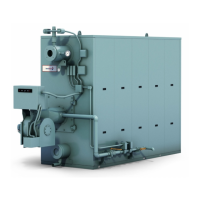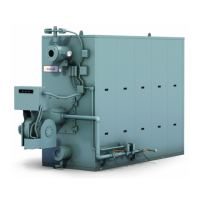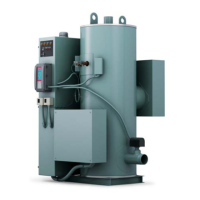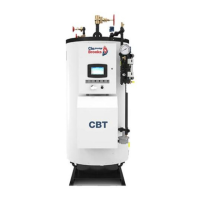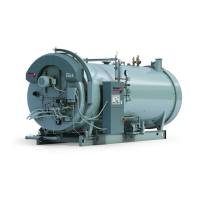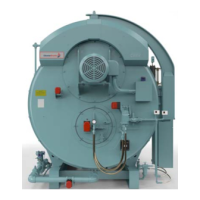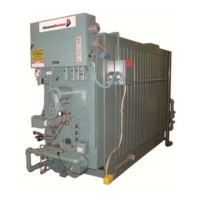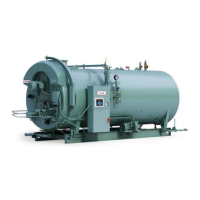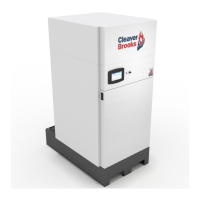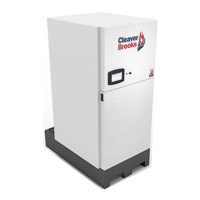Pressure Vessel Care Chapter 3
750-177 3-7
handhole cover. (Use standard service gaskets during the
boilout procedure.)
3. The relief valve(s) must be removed before adding the
boilout solution so that neither the solution nor the
contaminants that it may carry can come in contact with
the valve(s). Use care in removing, handling, and
reinstalling these valves.
Note: For relief valve installation
information, refer to Chapter 7,
Section E.
“Controls.”
4. Replace
the regular gauge glass with a temporary gauge
glass that can be discarded after the cleaning (steam
boilers).
5. An overflow pipe should be connected to one of the top
boiler openings and routed to a safe point of discharge. A
relief valve tapping is usually used for this purpose. The
overflow connection to the boiler should incorporate a
tee fitting for adding cleaning solution to the boiler.
6. Fill the unit with clean water to a point just below the
access port in the upper drum. It is important that the
water used for the filling process is at a temperature of
70F or above.
7. Add the boilout solution using a chemical pump.
!
DANGER
WARNING
The chemicals used in this procedure are
corrosive to eyes and skin. Always refer to
the Material Safety Data Sheet to ensure that
the proper safety equipment and
precautions are present. Failure to heed this
warning could result in serious personal
injury or death.
8. Reinstall the upper handhole cover.
9. Continue to fill the boiler until it is full (indicated by flow
from the overflow connection).
10. Recheck the burner, gauge glass, pressure gauge,
feedwater supply and the position of all valves. Make
sure that all water feeding and level indicating apparatus
are in proper working condition.
11. Fire the boiler intermittently at the burners lowest fire
rate until the water reaches the boiling point. The water
should be held at this temperature for at least five hours.
Note: Do not produce pressure in the boiler.
12. Throughout the entire process, each blow-down point or
valve should be blown at least once every two hours. The
total amount of water blown from all points each time
should be approximately one-half gauge glass, this
amount being equally divided among the various manual
blowdown points and continuous blowdown system.
Blow the surface and/or continuous blow-down points
first, followed by the other blowdown points lower on
the boiler. After each blowdown cycle, the water level
should be brought back to full. If the total alkalinity in
the cleaning solution falls to a level below 3000 ppm, it
may be necessary to add additional solution using a
chemical pump.
13
. Allow
a small amount of fresh water to enter the boiler in
order to create a slight overflow that will carry off
surface impurities. Continue to boil and overflow until
the water clears.
14. It is difficult to provide specific recommendations
regarding the duration of the cleaning process. In
general, a period of 18 to 36 hours will prove sufficient
to internally clean the water-side of the boiler. The
condition of the water blown from the boiler is the best
indicator as to whether the cleaning process is complete.
15. Discontinue firing, and allow the water to cool. After
letting the water cool to 120F or less, drain the boiler.
!
DANGER
WARNING
Be sure to drain the hot water to a safe point
of discharge to avoid the possibility of
scalding, serious personal injury or death.
16. Remove the drum handhole cover, and wash the
waterside surfaces thoroughly, using a high pressure
water stream. Direct the water stream into each
individual tube. If possible, this washing should be done
from the bottom up. A wash out lance is available from
your local Cleaver-Brooks authorized representative.
17. Inspect the waterside surfaces. If they are not clean,
repeat the boilout procedures.
18. Replace the handhole covers (using new gaskets) and
reinstall the relief valve(s).
Note: Refer to Chapter 7, Section E,
“Controls” for information regarding proper
installation of relief valves.
19. If the boiler is to be put into service immediately, fill the
boiler with clean, treated water and fire the burner until
the water has been heated to at least 180F to drive off
any dissolved gases that might otherwise corrode the
metal.
20. If the boiler is not to be put into immediate service, refer
to the section on boiler layup procedures in this chapter.
